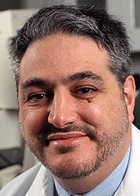The School of Medicine will be among the first recipients of a major new National Institutes of Health (NIH) grant to facilitate study of nervous system disorders. The NIH Blueprint for the Neurosciences Grant will provide $8 million to the University over five years.
The NIH also is renewing its support of the University’s innovative multidisciplinary stroke research program, providing $6 million over five years. Researchers funded by the grant are trying to determine if healthy connections between brain cells are critical to the cells’ ability to survive strokes.

Research funded by both grants will be administered through the Hope Center for Neurological Disorders. The Hope Center is supported by both the University and Hope Happens, a private foundation dedicated to raising money for research into neurodegenerative disorders.
Scientists partially credit the blueprint grant proposal’s success to the large number of established neuroscience investigators at the University.
“One of the criteria for evaluating the grant applications was the number of investigators already funded by NIH to study the nervous system,” said co-principal investigator Mark P. Goldberg, M.D., professor of neurology and of anatomy and neurobiology and director of the Hope Center. “We certainly have one of the largest bases in brain and nervous system science, with more than 300 grants.”
Scientists will use the grant funds to establish or expand seven cores, which are shared facilities that provide scientific services and processes regularly needed for research, including a core for creating viruses to alter the activity of important genes and a core for using advanced optical imaging techniques to monitor experimental results.
Each core will be located in a different department at the medical school, creating a network potentially accessible to any scientist, clinical or basic, who studies aspects of nervous system disease and function.

“What’s nice about the blueprint grant is that it allows us to do work not only at the bench with molecules, cells and animal models, but also at the bedside with human patients,” said principal investigator David M. Holtzman, M.D., the Andrew and Gretchen Jones Professor and chair of Neurology.
The blueprint grant program is one of the first initiatives of NIH’s Blueprint for Neuroscience Research. Like the broader NIH Roadmap for Medical Research, it was designed to encourage innovative approaches to scientific challenges by fostering collaboration between different research specialties.
The ultimate goal of both NIH initiatives and the University’s own Biomed 21 initiative is to accelerate the transformation of laboratory insights into improved patient treatment.
Goldberg said the success of the University’s blueprint grant proposal is partially attributable to pledges of additional support and funding from the School of Medicine, the Hope Center, the McDonnell Center for Higher Brain Function and the McDonnell Center for Cellular and Molecular Neurobiology.
Goldberg is principal investigator for the recently renewed stroke grant, now funded through its 17th year. Researchers have long noted that stroke leads brain cells to release a flood of excitatory neurotransmitters that can cause brain cells to self-destruct.
“The drugs that we’ve developed to stop these excitatory processes, which are based on mouse models, have mostly failed to work in humans,” Goldberg said. “Our research program is looking at whether a key difference between mouse and human brains could account for this lack of significant progress. That difference is the number of connections between brain cells.”
Scientists call the portion of the brain comprised of connections between brain cells white matter. Ten percent of the mouse brain is white matter; the human brain, in contrast, is about 50 percent white matter.
“There’s no question that a brain cell’s response to excess excitatory neurotransmitters is important to its survival during stroke,” Goldberg said.
“But what we’ve started to ask is whether the cells’ survival also hinges on keeping the connections between brain cells working.”